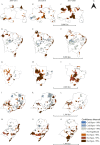Human immunodeficiency virus epidemic scenery among brazilian women: a spatial analysis study
- PMID: 37658362
- PMCID: PMC10474736
- DOI: 10.1186/s12905-023-02616-5
Human immunodeficiency virus epidemic scenery among brazilian women: a spatial analysis study
Erratum in
-
Correction to: Human immunodeficiency virus epidemic scenery among brazilian women: a spatial analysis study.BMC Womens Health. 2023 Sep 15;23(1):490. doi: 10.1186/s12905-023-02655-y. BMC Womens Health. 2023. PMID: 37715223 Free PMC article. No abstract available.
Abstract
Background: Approximately 37.7 million people worldwide are infected with human immunodeficiency virus (HIV). Although HIV detection among women, they still representing 53% of population living with the virus. Spatial analysis techniques are powerful tools for combating HIV allowing the association of the phenomenon with socioeconomic and political factors. Therefore, the main goal of this study was to spatially analyze HIV prevalence among Brazilian women from 2007 to 2020.
Methods: ecological study was conducted using secondary databases of the Notifiable Diseases Information System (SINAN) for HIV and Acquired Immunodeficiency Syndrom (AIDS) in Brazilian women 15 years old and over. Age-adjusted HIV/AIDS incidence rates were analyzed using spatial distribution, autocorrelation, and spatiotemporal risk analysis techniques.
Results: During the study period, 119,890 cases of HIV/AIDS were reported among Brazilian women. The southeastern region had a higher age-adjusted HIV/AIDS incidence than other Brazilian regions. Hotspot HIV/AIDS incidence rates decreased in all Brazil. Piauí, Paraná, and Minas Gerais were the only states with an increased number of cold spots. Previous spatiotemporal risk zones were observed in the states of São Paulo, Rio Grande do Sul, and Rio de Janeiro. Belém was a risk zone with a later spatiotemporal risk.
Conclusions: The efficiency of public policies fighting HIV has not been uniform among municipalities, although HIV/AIDS cases have decreased among Brazilian women. The social determinants of health in each municipality should be considered when local health authorities implement policies. Women empowerment should be promoted, and access to preventive, diagnostic, and treatment healthcare places should be expanded and guaranteed.
Keywords: Brazil; HIV; Spatial analysis; Women.
© 2023. BioMed Central Ltd., part of Springer Nature.
Conflict of interest statement
The authors declare no conflict of interest.
Figures



References
-
- THE JOINT UNITED NATIONS. PROGRAMME ON HIV/AIDS (UNAIDS). Estatísticas. 2022. - PubMed
-
- BRASIL. Secretaria de Vigilância em Saúde. Ministério da Saúde. Boletim Epidemiológico [Internet]. Available from: http://antigo.aids.gov.br/system/tdf/pub/2016/77/boletim_epidemiologico_....
-
- THE JOINT UNITED NATIONS PROGRAMME ON HIV/AIDS (UNAIDS). Number of new infections by sex – Global – 2010–2019. 2020.
Publication types
MeSH terms
LinkOut - more resources
Full Text Sources
Medical

